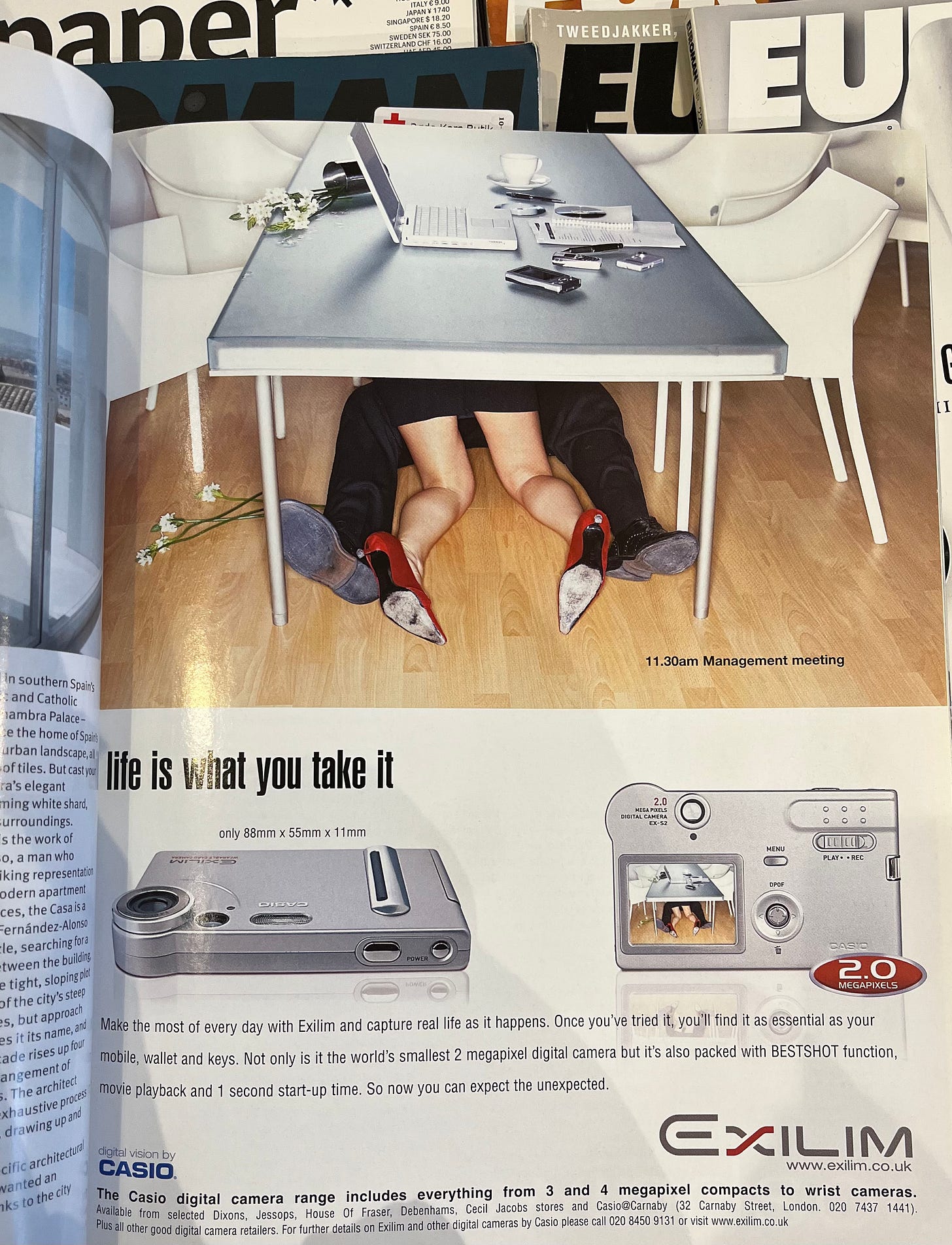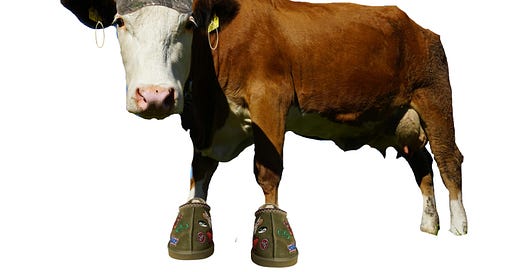In August of this year, I returned to London after a month away. Working from my sleepy hometown in Germany had been a welcome break from the endless momentum of the city. Every distance was walkable. A retiree’s oasis. Then, I was back - perched in a stifling Victoria line carriage after a summer of travel by foot and tram. But the first thing that struck me wasn’t the metallic taste of exhaust fumes or the droopy faces of passers by. It was the deluge of advertisements, pasted on every available surface. Airlines, accounting apps, fintech, poo-improving dog food, reality television, alcoholic beverages, non-alcoholic beverages that taste like alcoholic beverages, taxi companies, food delivery services… Not a single place to rest a weary eye.
After a month spent in a low population density town where advertising trawlers don’t bother to venture because they would find their nets empty, my return to retail mecca felt like an assault on the senses. Reminded of just how many ways there are to spend my (just about) living wage salary, I began to ask myself: why does this all feel so icky? After all, I’m an adult, capable of making informed decisions, capable of budgeting - capable, allegedly, of choosing not to buy. But sometimes I still find myself in line for the checkout, a pack of hydrocolloid pimple patches or alkaline bottled water in hand.
I’m not alone in feeling overwhelmed by a million solutions for the problems I didn’t know I had.1 Advertising has become ubiquitous across all forms of media. 1 in 4 young Americans aspire to make a career out of it, via paid influencing, and in 2023, global digital advertising spend reached $601bn. Not adjusting for inflation, that’s $100bn more than the entire global advertising spend in 2010.2
So? The omnipresence of advertising and - the fatigue associated with it - aren’t life or death issues. They are, however, symptoms of a wider problem - a culture of overproduction and overconsumption that is only gaining momentum despite (lukewarm) efforts to put on the brakes3. Right now, during a period of high inflation rates and a rising cost of living, unsecured credit providers like Klarna are gaining popularity, unlocking luxury goods beyond the average consumer’s financial means. If adverts are doing their job, they’re a major factor in convincing people to go into debt for a pair of shoes4. But how to escape? Why, even, if pinching pennies feels futile anyway in this economy?
These organic tampons will change your life
To understand why we don’t have as much conscious control over our behaviour as consumers, we need to understand the hidden systems shaping it. Bear with me.
Before the postwar period in Europe and the U.S (A.K.A the ‘Golden Age of Capitalism5’), advertising consisted largely of text-heavy, claims about a product’s quality and benefits, relying on the conscious decision of potential customers to buy or not to buy. After the Second World War, efforts to improve trade relations, military industrial advancement repurposed for the mass-production of consumer goods, abundant labour forces and a resulting quadrupled GDP per capita growth rate came together to create the economic boom that laid the groundwork for 21st Century Capitalism. Suddenly: people were working, earning, and spending their money.
But to keep the money flowing, people needed to buy more - buy more than what they needed, more than was necessary to enjoy a secure and stable life. Claims like “THE GOODS ARE NEW AND FASHIONABLE” weren’t going to cut it anymore. So: how to get people to part with their hard earned cash?

As industry insider Dee Madigan6 puts it, advertising as we know it today was built on a process of convincing people that things they do not need are essential goods. Citing Maslow’s infamous hierarchy of needs7, Madigan writes:
“The space under our kitchen sinks is full of products we do not really need but we have purchased because somehow we have bought into the marketing that they are important for the health/security of our family. [...] Maternal guilt is a prime motivator for advertisers.”
We connected dish soap to skin health, cornflakes to morality and a lot of (completely unrelated things) to sex. And thus consumer goods have become vehicles for the flows of cash that support the various industries associated with their genesis, whilst convincing us they’re indispensable for a healthy and fulfilling life.

The first way of freeing yourself from wasting your money is understanding the difference between what you really need and what you’re being told you need. Not every product is for everyone - but marketers are casting a wide net, and now teenagers are spending their pocket money on anti-ageing retinoids.
I’m not advocating for extreme frugality or immortalising your credit card in an ice block à la Rebecca Bloomwood in Confessions of a Shopaholic. I do think there’s a case to be made for focussing your spending power on the things that make sense for you, though… and only you know what those things are. No matter how scarily specific your targeted ads get.
We can’t all be tomato girls
In our world of planned obsolescence, quality is secondary. As the market saturates, advertisers are forced to innovate. And by innovate, I mean more effectively manipulate, for example through targeted advertising or literal neuromarketing8. Like other magical algorithmic machinations, these bad boys can either take the hard graft out of online shopping, or shove unsolicited Saucony running shoes you can’t afford down your throat for a week because you googled them once. They also put you in a taste-box based on contextual, demographic, behavioural or other targeting criteria. What people in your postcode, age group, with your health condition are converting on is the basis of a model that works by defining you, and trying to shape your behaviour accordingly.
From Goffman9 to Belk10, psychologists and sociologists have long emphasised the importance of possessions for our individual sense of identity. A man who hasn’t touched a canvas in forever remains an artist if his easel still stands at the ready, his overalls are still smeared with paint from three years ago. In the same way, a teenage girl ascends to loftier social strata with the right pair of platform Uggs on her feet, even if she has to use Klarna to pay for them. Your identity shapes what you buy, wear and use - but these objects also unlock new realities and have the power to shape you right back.
I’m not advocating for commodity fetishism here. On the contrary, I think that allowing ads to guide how you spend your money (when you can help it) is a slippery slope to becoming someone you aren’t. Acrylic nails and bleached hair can be hot - but I never should’ve gone down that road myself. Unfollowing influencers and questioning whether TikTok really knows me better than I know myself helped to soak that glue right off.
I get it. Having the magical voice of the data Gods whisper the secrets of aesthetic relevance in your ear can be incredibly convenient and effective for building your avatar. However: I’m a firm believer that the unexpected is sexy! Go off piste and see what makes you happy, what really feels like you. Whether it’s a a new habit, a new philosophy, or a new coat, there’s a wealth of ways to build on who you are.
Implanted desire
Some little treats are a hedonistic window of pleasure beyond the walls of mundanity. Others just pretend to be (like our spicy Casio camera ad from earlier). It’s likely that an advert using words like ‘guilty pleasure’ or ‘indulgence’ is trying to convince you that the reason you don’t have it yet is shameful self-denial rather than because you… just don’t want it.
I too find great joy in beautiful things. I love antique furniture, ceramics, flowers, a good hand-me-down coat, perhaps dug out from one of my mother’s cardboard moving boxes that have stood in waiting, untouched since 1998. I know that buying something I’ll live with for a long time will make me happy. I also know that I feel sick if I dig through the piles of clothes at the back of my closet and find a trend-led piece of crap I bought when I was 19, that I now have to flog on Vinted. Save yourself the pain! Do you really want that lip balm phone case?
You still won’t be able to afford a mortgage if you stop buying avocados. But you might be able to focus on things and experiences that actually feel like you, instead. Many of us already spend a good portion of our lifetimes filling in Excel spreadsheets for money. I’d rather not spend my bit of surplus on shit I don’t need.
Look no further than ‘underconsumption core’, the trend where chronically online people rediscover normal levels of consumption.
Also, about half the women I know from University (including myself) work in marketing-adjacent roles. The humanities-to-advertising pipeline is real. An estimated 80% of job vacancies I found after graduating were marketing roles. Perhaps it was naïve to think I’d be using my knowledge of group psychology for positive change.
We know that the ballooning production of consumer goods has dire consequences for the environment and industrial workers. Unfortunately, we in the Global North are often far removed from the direct effects of our overconsumption. We’re also really good at avoiding dealing with problems until someone shits on our own doorstep.
Yes, 90% of transactions on similar ‘buy now, pay later’ services are fashion and footwear-related according to a report by the FTC.
Toniolo, Gianni. “Europe’s Golden Age, 1950-1973: Speculations from a Long-Run Perspective.” The Economic History Review, vol. 51, no. 2, 1998, pp. 252–67. JSTOR, http://www.jstor.org/stable/2599377. Accessed 20 Oct. 2024.
Madigan, Dee. “Advertising and Change: Message, Mind, Medium, and Mores.” Change!: Combining Analytic Approaches with Street Wisdom, edited by Gabriele Bammer, ANU Press, 2015, pp. 81–90. JSTOR, http://www.jstor.org/stable/j.ctt16wd0cc.10. Accessed 14 Oct. 2024.
This is an increasingly popular approach to marketing which uses scientific knowledge of subconscious cognitive processes to improve ad effectiveness. In other words, trying to sneak in the back door.
Goffman, Erving. The Presentation of Self in Everyday Life. Bantam Doubleday Dell Publishing Group, 1959.
Belk, Russell W. “Possessions and the Extended Self.” Journal of Consumer Research, vol. 15, no. 2, 1988, pp. 139–68. JSTOR, http://www.jstor.org/stable/2489522. Accessed 22 Oct. 2024.





